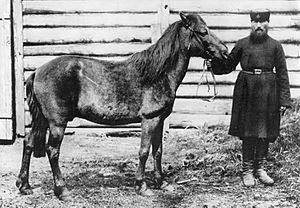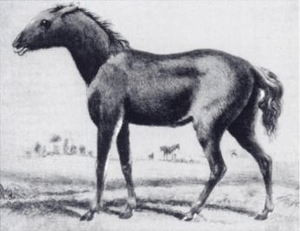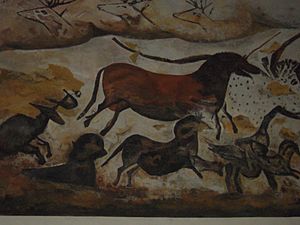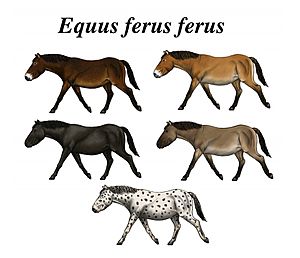Tarpan facts for kids
Quick facts for kids Tarpan |
|
|---|---|
 |
|
| Only known live photo of an alleged tarpan, which may have been a hybrid or feral animal, 1884 | |
| Conservation status | |
|
Extinct (1909)
|
|
| Scientific classification |
|
| Kingdom: | Animalia |
| Phylum: | Chordata |
| Class: | Mammalia |
| Order: | Perissodactyla |
| Family: | Equidae |
| Genus: | Equus |
| Species: | |
| Subspecies: |
†E. f. ferus
|
| Trinomial name | |
| Equus ferus ferus Boddaert, 1785
|
|
| Synonyms | |
|
|
The tarpan (Equus ferus ferus), also called the Eurasian wild horse, was a type of wild horse that is now extinct. This means it no longer exists anywhere in the world. The very last tarpan thought to be a pure wild horse died in a zoo in Russia in 1909. However, some people think this last horse might have been a mix of wild and tame horses.
Starting in the 1930s, people tried to create horses that looked like tarpans. They did this through selective breeding, which means choosing horses with certain traits to have babies. This process is sometimes called "breeding back." The new horse breeds that came from this include the Heck horse and the Konik. These horses look very old-fashioned, especially with their grey-brown coat color called grullo. Some people now sell these horses as "tarpans." But experts who study ancient wild horses say that "tarpan" should only describe the true wild horse that is now extinct.
Contents
What's in a Name?
The name "tarpan" comes from a Turkic language (like Kazakh or Kyrgyz). It simply means "wild horse." In the past, people like the Tatars and Cossacks used different names for truly wild horses and horses that had escaped from farms (called feral horses).
Today, the word "tarpan" is used in different ways. It can mean the ancient ancestor of all modern horses, or the specific wild horse that lived until recent times. It can also refer to any old-style European "wild" horses. The modern horses that were "bred back" to look like tarpans are also sometimes called "tarpans" by their fans. But these horses mostly come from domestic horse families.
Horse Family Tree
The tarpan was first described by a scientist named Samuel Gottlieb Gmelin in 1771. He saw these horses in Russia. Later, in 1784, Pieter Boddaert officially named the species Equus ferus. Scientists now believe that the modern horse (Equus caballus) came from the tarpan. Many experts think they are actually the same species.
There's a debate about whether the small, free-roaming horses seen in Europe in the 1700s and 1800s were truly wild. Some think they were never tamed, while others believe they were mixes of wild horses and farm animals, or just feral horses. Most studies have looked at only two preserved tarpan bodies. So far, research hasn't fully proven that these later tarpans were directly linked to very ancient wild horses.
How Tarpans Looked
People used to think there were two types of tarpans: forest tarpans and steppe tarpans. But most experts now agree there was only one type, Equus ferus ferus. The last known tarpan, which died in 1909, was about 140 to 145 centimeters (about 4.5 to 4.7 feet) tall at the shoulder. It had a thick, falling mane (the hair on its neck). Its coat was a grullo color, which is a grey-brown. It also had dark legs and "primitive markings." These markings include a dark stripe down its back (called a dorsal stripe) and stripes on its shoulders.
Scientists have studied the genes for coat colors in ancient European wild horses. They found genes for bay (reddish-brown), black, and spotted coats. These colors are shown in old cave paintings. The dun gene, which gives horses a duller, more muted color like the grullo seen in Koniks, has not been fully studied in ancient European wild horses. But it's likely some wild horses had dun coats.
Some people think tarpans had a standing mane, like other wild horses today. But old descriptions don't clearly say this. It's more likely they had a short, falling mane. This type of mane helps rain and snow run off the neck, keeping the horse warmer. Ancient wild horses found preserved in Siberia also had hanging manes.
Scientists can guess what European wild horses looked like using genetic information, bone studies, and old records. One study suggests that bay was the most common color. Later, a black coat color appeared in Spain and spread east. It was less common than bay and didn't reach Siberia. Bay combined with dun creates the "bay dun" color seen in Przewalski's horse. Black with dun creates the grullo coat. Darker colors might have helped horses hide better in forests. Tarpans probably also had Pangaré (lighter areas on the muzzle and belly) and primitive markings like stripes on their shoulders, legs, and spine.
A Look Back in Time
Wild horses have lived in Europe since the Pleistocene Ice Age. They roamed from southern France and Spain all the way to central Russia. You can see drawings of these ancient horses in caves like Lascaux, France, and Altamira, Spain. People in southern Russia started taming horses around 3000 BCE. Equus ferus lived across a huge area, from western Europe to Alaska. Records show wild horses lived in most parts of Europe and Asia, except for places like Scandinavia and Ireland.
Forest Horses
Some scientists in the 1800s thought there was a special "forest horse" type of tarpan. They believed that as Europe became more forested after the last ice age, a type of wild horse adapted to living in forests. However, old records don't describe big differences between horse groups. So, most experts think there was only one type of western Eurasian wild horse, Equus ferus ferus.
Still, people in the 1800s described a strong type of horse living in forests and highlands in places like Spain, the Pyrenees, and Great Britain. These horses had strong heads, powerful bodies, and long, curly manes. Their color was often light brown or yellowish-brown with a dark stripe down the back and stripes on their legs. Some were even ash-colored. They lived in rocky areas and were known to be smart and fierce.
Black wild horses were also found in Dutch swamps. They had large skulls, small eyes, and bristly muzzles. Their manes were full, and they had wide hooves and curly hair. But these might have been feral horses, not truly wild ones.
An ancient Greek writer named Herodotus described light-colored wild horses in what is now Ukraine around 500 BCE. In the 1100s, Albertus Magnus wrote about mouse-colored wild horses with dark stripes living in Germany. Large herds were hunted in Denmark.
Tarpans in the 1500s and 1600s
Wild horses were still common in eastern Prussia in the 1400s and early 1500s. But by the 1500s, they had mostly disappeared from western Europe and became less common in eastern Europe too. A scientist named Belsazar Hacquet saw wild horses in a Polish zoo in Zamość during the Seven Years' War. He said these horses were small, dark brownish-black, with large, thick heads, and short, dark manes and tails. They were very wild and fought hard against danger.
Another visitor to the Zamość zoo, Kajetan Kozmian, said they were small, strong, and had sturdy legs. They were always a dark mouse color. Samuel Gottlieb Gmelin saw herds in Voronezh, Russia, in 1768. He described them as very fast and shy, running away from any noise. They were small, with tiny, pointed ears and short, curly manes. Their tails were shorter than those of domestic horses. They were usually mouse-colored with a light belly and legs that turned black. Some gray and white horses were also mentioned. Their coats were long and thick.
Peter Simon Pallas saw what might have been wild tarpans in southern Russia in the same year. He thought they were feral animals that had escaped during wars. These herds were important for hunting by the Tatars. They usually had between 5 and 20 horses. The horses he described were small, with large, thick heads, short curly manes, and short tail hair. Their ears were pointed. Their color was usually light brownish, sometimes brown or black. He also saw horses that looked like mixes with domestic horses, having light-colored legs or gray coats.
The Last Tarpans
A book from the 1800s, The Natural History of Horses by Charles Hamilton Smith, also described tarpans. Smith said wild horse herds could have a few or hundreds of animals. They often mixed with domestic horses, and there were also herds of feral horses or mixed breeds. Pure tarpans were always described as brown, cream-colored, or mouse-colored. Their short, curly manes were black, as were their tails and legs. Their ears were different sizes but set high on their heads. Their eyes were small.
According to Smith, tarpans made louder sounds than domestic horses and looked a bit like mules. A tarpan herd lived in the Zamość zoo until 1806. The zoo had to sell them because of money problems. They were given to local farmers in the Biłgoraj region, tamed, and bred with domestic horses. Wild horses had been wiped out in the Polish wilderness just before this, because they ate hay meant for farm animals.
Why Tarpans Disappeared
Humans caused the tarpan to become extinct. This started in Southern Europe, possibly a very long time ago. People had been hunting wild horses since the Paleolithic (Stone Age). In later times, horse meat was an important food source for many cultures. As more and more people lived in Europe and Asia, the areas where tarpans could live became smaller. Wild horses were also hunted because they ate hay meant for farm animals. They also sometimes took domestic mares from pastures. When wild horses bred with farm mares, their foals (babies) were often "intractable," meaning they were very difficult to control or manage.
Tarpans survived longest in the southern parts of the Russian steppe. By 1880, most "tarpans" might have been mixed breeds. Truly wild horses became very rare. In 1879, the last scientifically confirmed wild tarpan was killed. After that, only a few doubtful sightings were reported. The last wild tarpan mare died by accident during an attempt to capture her. The very last tarpan in captivity died in a Russian zoo in 1909.
In the early 1800s, the Polish government tried to save the tarpan type. They set up a special area in Białowieża for horses that came from tarpans. This wildlife park protected a group of tarpans until the early 1800s. When the park closed in 1806, the last tarpans were given to local farmers. It is believed they survived by breeding with domestic horses. The Konik horse breed is said to come from these mixed horses. Recent studies show that Konik horses living freely in the Netherlands have different body shapes compared to other modern domestic horses.
Wild Horses vs. Feral Horses
Some researchers think that the tarpans seen in their last two centuries were actually a mix of wild and feral horses, or even completely feral horses. Feral horses are domestic horses that have escaped and live in the wild. Few experts believe that the "tarpans" seen more recently were truly wild horses with no domestic influence. Old records of "wild horses" might have actually been about feral domestic horses or mixed breeds.
Some writers in the 1800s said that local "wild" horses had hoof problems, which made them lame. They thought this meant these horses were feral. Other writers at the time claimed all "wild" horses between the Volga River and the Ural Mountains were actually feral. However, others thought this was just guessing and believed that truly wild, untamed horses still lived in the 1800s. Domestic horses used in wars were often let go when they were no longer needed. Also, remaining wild stallions could sometimes take domestic mares from farms. There are some stories from the 1700s and 1800s about wild herds with typical wild horse features like large heads, pointed ears, and short, curly manes and tails. But these stories also mentioned animals that showed signs of domestic influence.
The only known tarpan to be photographed was called the Cherson tarpan. It was caught as a foal in 1866 and died in 1887 in the Moscow Zoo. People at the time doubted if this horse was truly wild because it didn't have many of the wild horse features described in old records. Today, it's thought that this horse was either a mixed breed or a feral domestic horse.

Breeding Back Wild Horses
People have tried three times to use selective breeding to create a horse type that looks like the tarpan. But it's important to remember that bringing back an extinct animal exactly is not possible with today's science.
In 1936, a Polish professor named Tadeusz Vetulani chose Polish farm horses, then called Panje horses (now Konik horses). He believed they looked like the historic tarpan. He started a breeding program. While his work is well-known, it only played a small part in creating the modern Konik horse. Koniks are genetically similar to other domestic horse breeds, like the Mongolian horse and the Thoroughbred.
In the early 1930s, brothers Lutz Heck and Heinz Heck from zoos in Germany started a program. They bred Koniks with Przewalski horses, Gotland ponies, and Icelandic horses. By the 1960s, they created the Heck horse. In the mid-1960s, Harry Hegard started a similar program in the United States. He used mustangs and local ranch horses. This led to the Hegardt or Stroebel's horse.
Are They Really Tarpans?
All three of these breeds (Konik, Heck horse, Hegardt horse) have an old-fashioned look that reminds people of the wild tarpan. But they are not genetically true tarpans. The real wild European horse is still extinct. However, some modern breeders still market horses with these features as "tarpans."
Even though Konik and Hucul horses look old-fashioned, their body shapes are quite different. This is thought to be partly because they live in different environments. Other breeds sometimes said to be surviving tarpans include the Exmoor pony and the Dülmen pony. But genetic studies don't show these breeds are different from other domestic horses. However, no study has directly compared domestic breeds with the ancient European wild horse yet.
See also
In Spanish: Tarpán para niños





